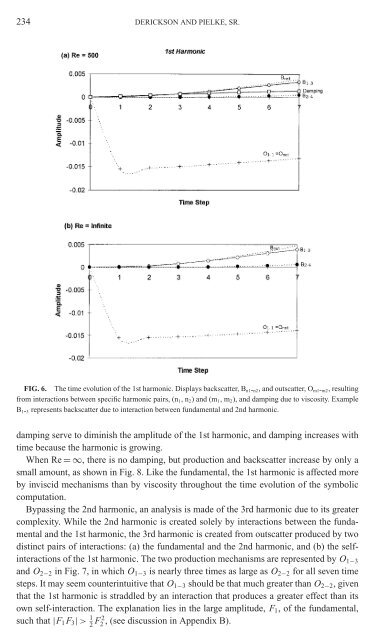A Preliminary Study of the Burgers Equation with Symbolic ...
A Preliminary Study of the Burgers Equation with Symbolic ...
A Preliminary Study of the Burgers Equation with Symbolic ...
You also want an ePaper? Increase the reach of your titles
YUMPU automatically turns print PDFs into web optimized ePapers that Google loves.
234 DERICKSON AND PIELKE, SR.<br />
FIG. 6. The time evolution <strong>of</strong> <strong>the</strong> 1st harmonic. Displays backscatter, Bn1-n2, and outscatter, Om1-m2, resulting<br />
from interactions between specific harmonic pairs, (n1,n2) and (m1,m2), and damping due to viscosity. Example<br />
B1-3 represents backscatter due to interaction between fundamental and 2nd harmonic.<br />
damping serve to diminish <strong>the</strong> amplitude <strong>of</strong> <strong>the</strong> 1st harmonic, and damping increases <strong>with</strong><br />
time because <strong>the</strong> harmonic is growing.<br />
When Re =∞, <strong>the</strong>re is no damping, but production and backscatter increase by only a<br />
small amount, as shown in Fig. 8. Like <strong>the</strong> fundamental, <strong>the</strong> 1st harmonic is affected more<br />
by inviscid mechanisms than by viscosity throughout <strong>the</strong> time evolution <strong>of</strong> <strong>the</strong> symbolic<br />
computation.<br />
Bypassing <strong>the</strong> 2nd harmonic, an analysis is made <strong>of</strong> <strong>the</strong> 3rd harmonic due to its greater<br />
complexity. While <strong>the</strong> 2nd harmonic is created solely by interactions between <strong>the</strong> fundamental<br />
and <strong>the</strong> 1st harmonic, <strong>the</strong> 3rd harmonic is created from outscatter produced by two<br />
distinct pairs <strong>of</strong> interactions: (a) <strong>the</strong> fundamental and <strong>the</strong> 2nd harmonic, and (b) <strong>the</strong> selfinteractions<br />
<strong>of</strong> <strong>the</strong> 1st harmonic. The two production mechanisms are represented by O1−3<br />
and O2−2 in Fig. 7, in which O1−3 is nearly three times as large as O2−2 for all seven time<br />
steps. It may seem counterintuitive that O1−3 should be that much greater than O2−2,given<br />
that <strong>the</strong> 1st harmonic is straddled by an interaction that produces a greater effect than its<br />
own self-interaction. The explanation lies in <strong>the</strong> large amplitude, F1, <strong>of</strong> <strong>the</strong> fundamental,<br />
such that |F1F3| > 1<br />
2 F 2 2 , (see discussion in Appendix B).














